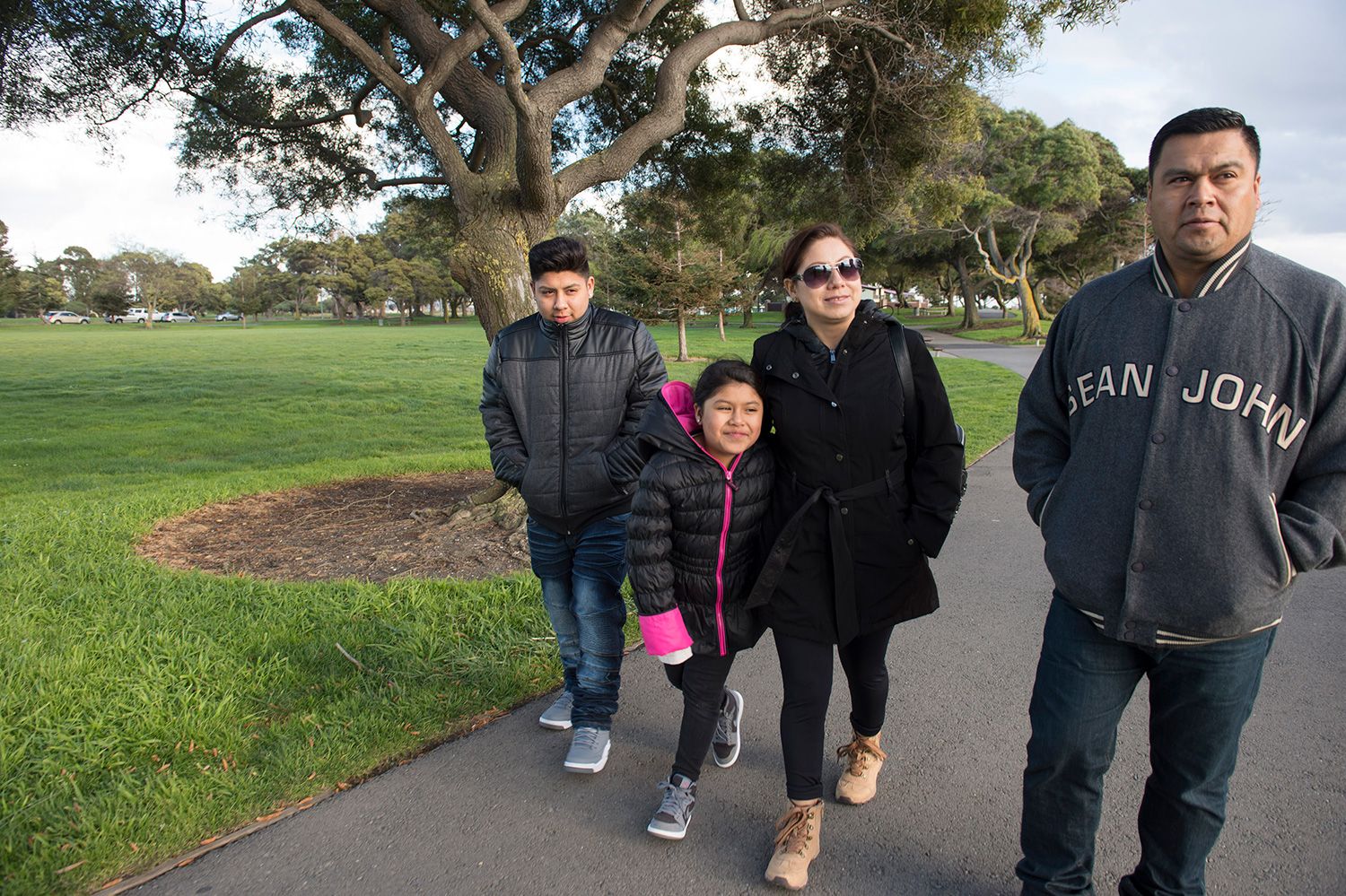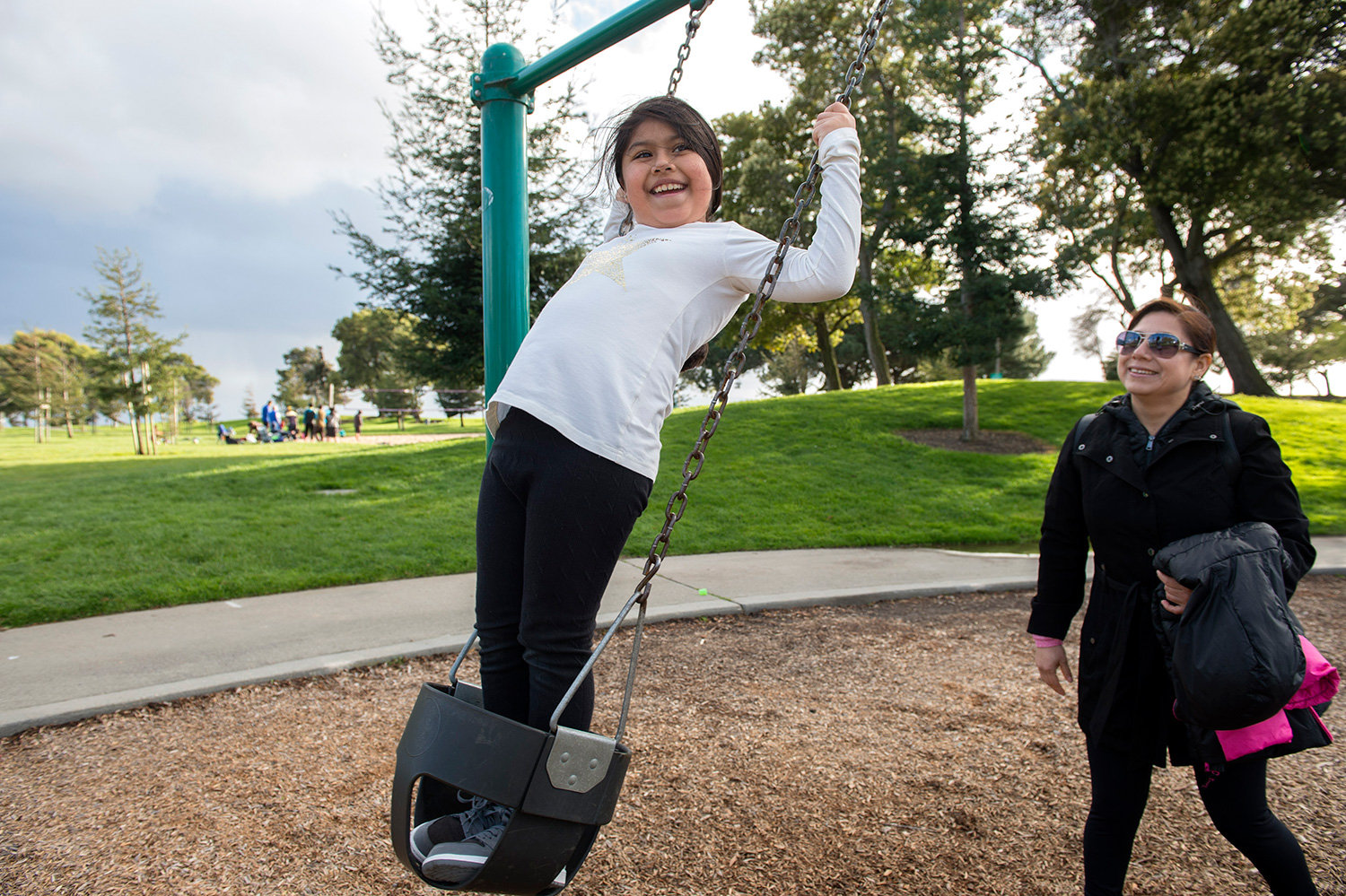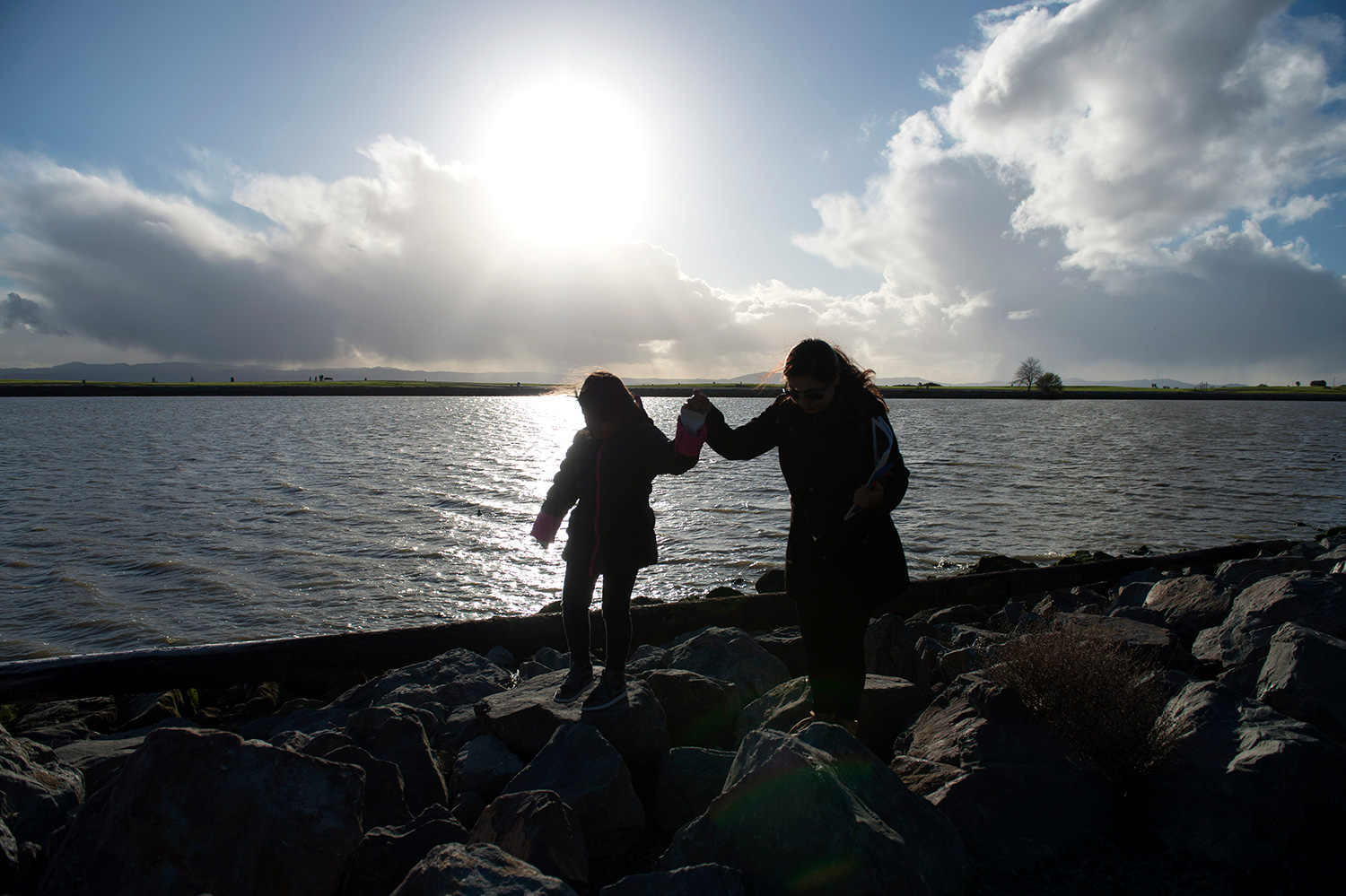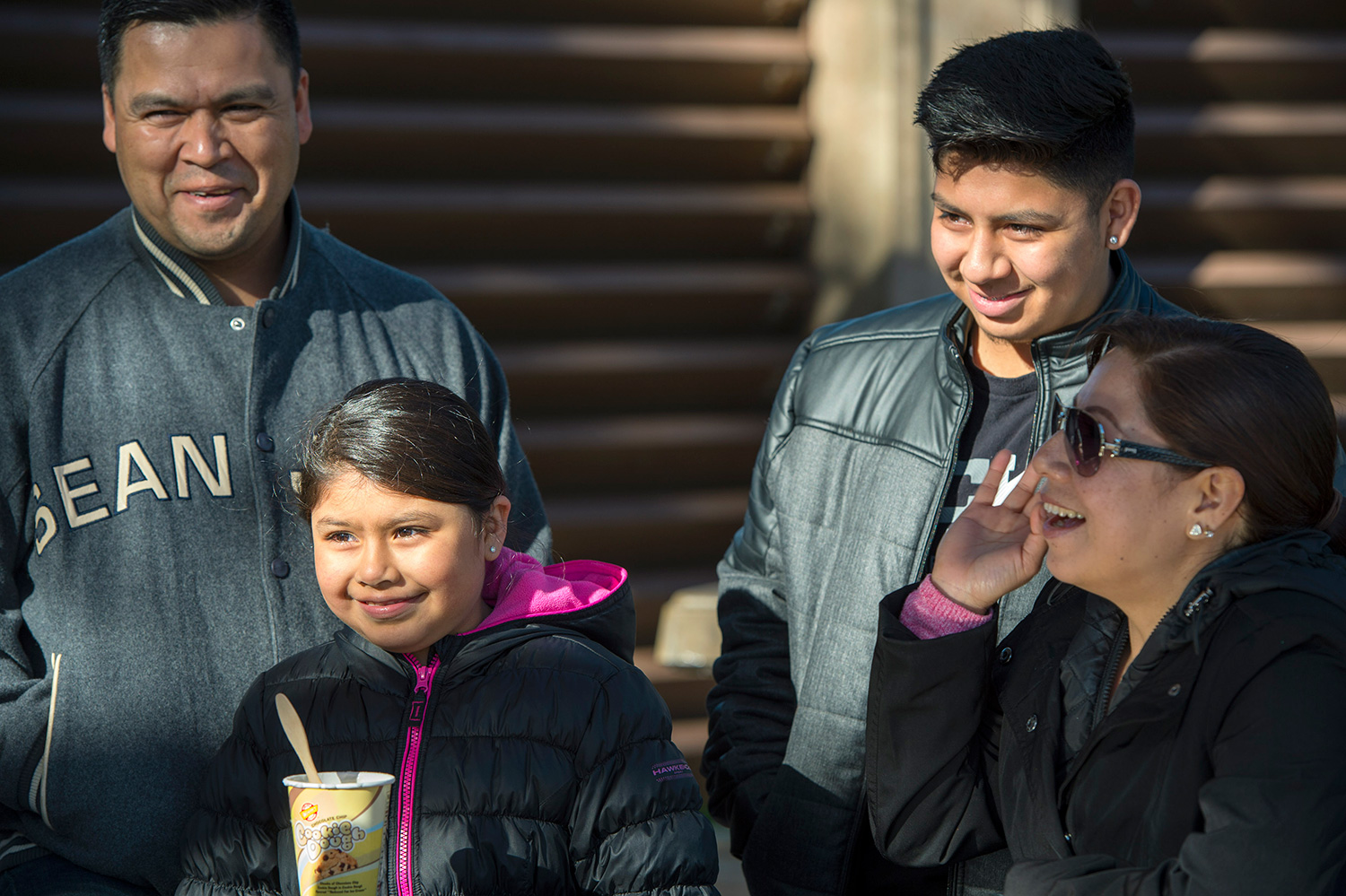


The Infante family, Fanny and Jose, and their children, Isaac,16,and Estrella, 8, a first generation immigrant family from Mexico, walks the Marina Park at San Leandro Marina.

Fanny pushes Estrella’s back to let her play with a swing.

Estrella and Fanny walk along the coast at the park.

For the Infante family, it is important to spend quality time together.
Raising children in the San Francisco Bay Area can be a challenge for any family. It is even more difficult for a first generation immigrant family.
Fanny and Jose Infante immigrated from Mexico to the United States. They live in East Oakland, California. Jose immigrated in 2005 from Mexico. His wife Fanny and son Isaac followed in 2007. Their daughter Estrella was born in 2008 in the United States.
The Infante family lives in a lower income Latino neighborhood in East Oakland. The community is known for its high crime rate.
“Because we live in Oakland it’s a little difficult. We don’t feel free to have our kids go outside,” Fanny noted. However, they have made the decision to live there because it is affordable and located next to many employment opportunities. Jose finds it easier to work construction jobs because he is close to many of Bay Area cities experiencing a building boom.
When Estrella was first born Fanny had to stay at home, but once she turned three, she was able to get babysitters at the ESL school while she took classes. She is now going to community education classes to become an office manager or supervisor.
Fanny receives some government assistance as an immigrant. She can take her classes for free through a program for Immigrants, and there are programs to help with their health care as well including La Raza in Oakland. “There is a lot of support for immigrants,” Fanny remarked.
Jose noted that many of his friends and colleagues live in Stockton and Tracy, California outside the Bay Area. They spend several hours daily commuting on congested highways. He said his friends usually have a 2-3 hour commute each way every day. Instead, Jose is happy to have a short commute and enjoy more quality time with his family.
Fanny does not see her family moving from her Oakland neighborhood. “People ask why don’t we move to a more secure city, but I have made roots in Oakland and the community,” she said.
It is important the Infante family spend quality time together. “All the time it’s together as a group,” said Jose. On weekends they often go to the San Leandro Marina. It has a large park where a diverse group of friends plays volleyball together. They now have friends of all ethnicities and economic backgrounds, and they enjoy learning about a lot of new cultures.
“I teach my kids to respect all cultures, and they need to be tolerant of other cultures,” Fanny explained. “We like to participate in other cultures. For example, we went to an event with Indian friends. Another time with friends from Peru.”
Isaac and Estrella attend public school in Oakland. They attend the Lighthouse Community Charter School (https://lighthousecharter.org/). It is located in East Oakland and has classes from kindergarten through 12th grade.
According to the Lighthouse website “charter schools” are independent public schools with rigorous curriculum programs and unique educational approaches. In exchange for operational freedom and flexibility, charter schools are subject to higher levels of accountability than traditional public schools. Charter schools, which are tuition-free and open to all students, offer quality and choice in the public education system.
The website also explains the difference between a traditional public school and a charter school: “Charter schools are exempt from many education regulations except health, safety, and discrimination related laws. Charter schools can define their curriculum independent of the local school board, have longer school days and year, and can spend funds in more flexible ways.”
Isaac started out at a neighborhood public elementary school in Oakland named REACH. He also went to middle school at Alliance Academy. They were the local public schools his family lived near and are known to have poor academic standards.
Education is important for the Infante family and Fanny and Jose attempted to get Isaac into the Lighthouse charter school. They had to apply for the school using the Oakland public school lottery system.
“There is a long wait list. It took me four years to get in,” Isaac said.
“I noticed in the regular high school it didn’t matter of their test scores they passed the grade,” noted Fanny. “In this school [Lighthouse] they what to be sure that all the students get the required credits to be able to attend university.”
Fanny noted that the classes at Lighthouse have about 20 students, where a class at other Oakland schools have 30-35 students.
Because Isaac is attending Lighthouse, Estrella was able to get into the school in kindergarten. Siblings have priority on the waitlist for the school.
Estrella’s classes have two teachers for the students. They also have a coach who helps them teach in their home language, Spanish, as well.
The Lighthouse charter school uses the STEAM system of learning. Estrella has math, science, art, reading, and writing in her classes. They also have bilingual education lessons as well.
Besides public funding from the state of California, the Lighthouse school also accepts private financing. Lighthouse school raises money from private donors, but they also hold fundraisers including walkathons and a carnival as well.
Estrella likes going to the school and loves the after school program which is free for the students. Her favorite after school class is pottery on Wednesday afternoon.
Isaac is happy attending Lighthouse as well, and there are after school programs for high school students as well. He also has a lot of support at the school including academic counselors.
“If I didn’t do my homework in the other schools the teachers didn’t care,” said Isaac. “I could just be sitting in that class doing nothing, or on my phone or I could walk out of class if I wanted to. But if here [Lighthouse] I walk out it’s an automatic referral [to detention].”
Fanny noted that the school has emotional support for the kids as well. She said the school feels like a small community and they have become close with the other families in the school.
Lighthouse has a majority Latino student population but also includes African-American, white, Asian and Pacific Islanders.
When asked what they felt about Donald Trump becoming President and what it means for their family, Fanny noted that “At the [Lighthouse] school on the day of the election when Trump was elected a lot of people were crying including the staff.”
“I think there is more racism and I am more worried about my children,” Fanny continued. “Before that, I felt safe in my community, but now I don’t.”
However, Jose isn’t worried about their and their children’s future in their adopted home. “The President is different, but for me, it is not a problem,” said Jose. “I work and spend time my family, and I don’t make any trouble.”
